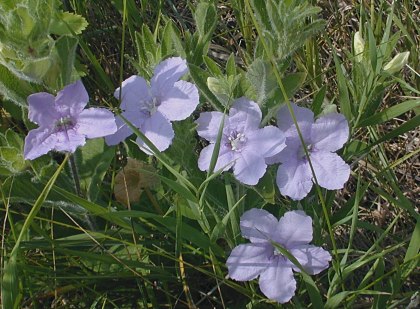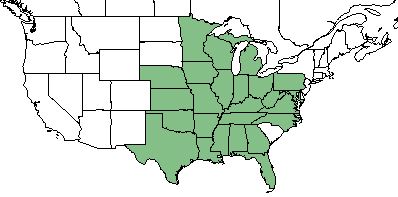Difference between revisions of "Ruellia humilis"
(→Ecology) |
|||
| Line 48: | Line 48: | ||
''R. humilis'' has no tolerance for fire.<ref name= "USDA"> [https://plants.usda.gov/core/profile?symbol=CEAM USDA Plant Database]</ref> | ''R. humilis'' has no tolerance for fire.<ref name= "USDA"> [https://plants.usda.gov/core/profile?symbol=CEAM USDA Plant Database]</ref> | ||
<!--Fire tolerance, fire dependence, adaptive fire responses--> | <!--Fire tolerance, fire dependence, adaptive fire responses--> | ||
| − | <!--===Pollination | + | <!--===Pollination and use by animals===--> |
| − | |||
<!--==Diseases and parasites==--> | <!--==Diseases and parasites==--> | ||
Revision as of 19:59, 23 June 2021
Common Names: fringeleaf wild petunia[1], low ruellia, fringed leaf ruellia[2]
| Ruellia humilis | |
|---|---|

| |
| Photo by John Hilty hosted at IllinoisWildflowers.info | |
| Scientific classification | |
| Kingdom: | Plantae |
| Division: | Magnoliophyta - Flowering plants |
| Class: | Magnoliopsida - Dicots |
| Order: | Scrophulariales |
| Family: | Acanthaceae |
| Genus: | Ruellia |
| Species: | R. humilis |
| Binomial name | |
| Ruellia humilis Nutt. | |

| |
| Natural range of Ruellia humilis from USDA NRCS Plants Database. | |
Contents
Taxonomic Notes
Synonym: none
Variety: R. humilis var. calvescens (Fernald), R. humilis var. frondosa (Fernald), R. humilis var. typica, R. humilis var. longiflora (A. Gray), R. humilis var. expansa (Fernald)
Description
R. humilis is a perennial forb/herb of the Acanthaceae family that is native to North America.[1]
Distribution
R. humilis is found in the eastern United States as far west as Texas, excepting South Carolina, New Jersey, New York, Delaware, Connecticut, Rhode Island, Massachusetts, Vermont, Maine, and New Hampshire.[1]
Ecology
Habitat
Common habitats for R. humilis include calcareous or mafic glades and woodlands, as well as prairies.[3] Specimens have been colelcted from dry slopes of a region with pine and oak, and open prairie regions.[4]
R. humilis can grow in any textured soil, coarse, medium and fine.[1]
This forb has a medium tolerance to drought, and is very tolerant of shade.[1]
Phenology
Flowering typically occurs during the summer months.[1]
Fire ecology
R. humilis has no tolerance for fire.[1]
Conservation, cultivation, and restoration
Cultural use
Photo Gallery
References and notes
- ↑ 1.0 1.1 1.2 1.3 1.4 1.5 1.6 USDA Plant Database
- ↑ Gee, K. L., et al. (1994). White-tailed deer: their foods and management in the cross timbers. Ardmore, OK, Samuel Roberts Noble Foundation.
- ↑ Weakley, A. S. (2015). Flora of the Southern and Mid-Atlantic States. Chapel Hill, NC, University of North Carolina Herbarium.
- ↑ URL: http://herbarium.bio.fsu.edu. Last accessed: June 2018. Collectors: Richard R. Clinebell II, William Platt, Sidney McDaniel, Randy Haynes States and counties: Georgia (Thomas) Alabama (Cherokee)